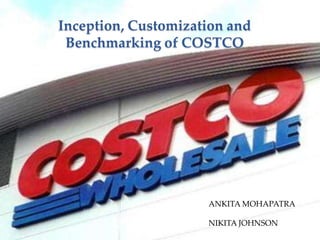Costcoppt 111104112451-phpapp0244444444
- 1. Inception, Customization and Benchmarking of COSTCO ANKITA MOHAPATRA NIKITA JOHNSON
- 2. Introduction ’ü▒ Founded in 1983 ’ü▒ Fifth largest retailer in the U.S. ’ü▒ As of 2012, 573 warehouses in 40 states and 7 countries ’ü▒ Fastest growing company in the history among American businesses
- 3. Costco ’ü▒ Only company to achieve $6 billion in sales from zero in six years ’ü▒ Founder Jim Sinegal coined as the inventor of the wholesale Club concept ’ü▒ Philosophy is to ŌĆ£keep members coming in to shop by wowing them with low prices.ŌĆØ ’ü▒ Does not engage in extensive advertisements or sale campaigns ’ü▒ Five Guiding Principles ’ü▒ Obey the law ’ü▒ Take care of members ’ü▒ Take care of employees ’ü▒ Respect suppliers ’ü▒ Reward shareholders Creative Exposure Consulting
- 4. Product Diversification ’ü▒ Core - Costco Wholesale ’ü▒ Warehouse Clubs and Superstores ’ü▒ Premium private-label products ’ü▒ Specialty - Consumer Services ’ü▒ Travel ’ü▒ Optical ’ü▒ Automotive ’ü▒ Financial Services ’ü▒ Loans ’ü▒ Insurance
- 5. Benchmarking
- 6. ŌĆó Benchmarking is the process of comparing one's business processes and performance matrices to industry bests or best practices from other industries. Dimensions typically measured are quality, time and cost. ŌĆó In this way, they learn how well the targets perform and, more importantly, the business processes that explain why these firms are successful.
- 7. The comparison is made between Costco and Walmart 1 ) lower operating margin 2) advertisement 3) Policy of James D. Sinegal ,co-founder and former COE of Costco 4) Costco doesnŌĆÖt concentrate on volume 5) Turnover 6) Shrinkage/Employee theft
- 8. 1 ) Costco has a lower operating margin Costco keeps around a 3% operating margin, which means for every dollar in sales they get 3 cents of profit before things like interest and taxes. WalmartŌĆÖs operating margin is around 6%, and targetŌĆÖs is almost 8%.
- 9. 2) Costco donŌĆÖt advertise In addition costco donŌĆÖt advertise in that way saves 2 percent a year in costs.
- 10. 3) Policy of James D. Sinegal ,co-founder and former COE of Costco Mr. SinegalŌĆÖs elbows can be sharp as well. As most suppliers well know, his gruff charm is not what lets him sell goods at rock-bottom prices ŌĆō itŌĆÖs his fearsome toughness, which he rarely shows in public. He often warns suppliers not to offer other retailers lower prices than Costco gets. When a frozen-food supplier mistakenly sent Costco an invoice meant for Wal-Mart, he discovered that Wal- Mart was getting a better price. ŌĆ£We have not brought that supplier back,ŌĆØ
- 11. 4) Costco doesnŌĆÖt concentrate on volume A typical Costco store stocks 4,000 types of items, including perhaps just four toothpaste brands, while a Wal-Mart typically stocks more than 100,000 types of items and may carry 60 sizes and brands of toothpastes. Narrowing the number of options increases the sales volume of each, allowing Costco to squeeze deeper and deeper bulk discounts from suppliers.
- 12. 5) Turnover CostcoŌĆÖs practices are clearly more expensive, but they have an offsetting cost-containment effect: Turnover is unusually low, at 17% overall and just 6% after one yearŌĆÖs employment. In contrast, turnover at Wal-Mart is 44% a yearŌĆÖclose to the industry average. In skilled and semi-skilled jobs, the fully loaded cost of replacing a worker who leaves (excluding lost productivity) is typically 1.5 to 2.5 times the workerŌĆÖs annual salary. To be conservative, letŌĆÖs assume that the total cost of replacing an hourly employee at Costco or SamŌĆÖs Club is only 60% of his or her annual salary. If a Costco employee quits, the cost of replacing him or her is therefore $21,216. If a SamŌĆÖs Club employee leaves, the cost is $12,617. At first glance, it may seem that the low-wage approach at SamŌĆÖs Club would result in lower turnover costs. But if its turnover rate is the same as Wal-MartŌĆÖs, SamŌĆÖs Club loses more than twice as many people as Costco does: 44% versus 17%. By this calculation, the total annual cost to Costco of employee churn is $244 million, whereas the total annual cost to SamŌĆÖs Club is $612 million. ThatŌĆÖs $5,274 per SamŌĆÖs Club employee, versus $3,628 per Costco employee.
- 13. 6) Shrinkage/Employee theft For example, it had extremely low employee shrinkage. While the industry average was somewhere between 2 and 4 percent, CostcoŌĆÖs was less than 0.02 percent. Managers believed that their good wages and benefits were the reason that employee theft was so low.














